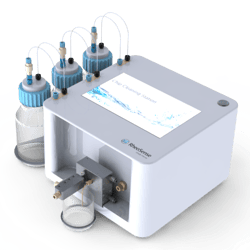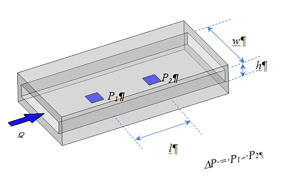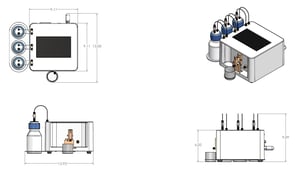At RheoSense, our customers are our greatest asset, and we love to engage in dialog on how we can be of assistance to their work and/or research. One such dialog we’ve had is how the cleaning process can be streamlined on the microVISC and the m-VROC. The cleaning process on these instruments is simple, but it is not automated like on our VROC initium one plus automatic viscometer and does require an operator to perform the cleaning steps. With this in mind, we unleased our talents and creativity and created our Chip Cleaning Station - or the CCS! A lot of time and effort go into developing a new instrument. Going from an idea, then onto the engineering and design of each component is a huge task. Not to mention the importance of design and user experience and user interface.
A lot of time and effort go into developing a new instrument. Going from an idea, then onto the engineering and design of each component is a huge task. Not to mention the importance of design and user experience and user interface.
In this blog we will give you a peak into thinking behind the pre-loaded cleaning protocols and what parameters impact their design.
Channel depth:
Our VROC technology (Viscometer, Rheometer On a Chip) is adaptable and flexible and this allows for a very wide dynamic range. Our m-VROC for example has a viscosity range of 0.2cP to over 100,000cP and a shear rate range of 0.5 1/s to 1,400,000 1/s. How this can be accomplished is by manipulating channel depth; channel depth range is from 20um up to 300um. With this flexibility, however come some unique challenges due to these varying of geometries. Therefore, each preloaded protocol will specify which channel depth a particular cleaning protocol is designed for. You may wonder why would there be a difference in how the different chips are cleaned? The scale is minute, we are talking micron scale! Well, in this micron universe slight variations in energy or forces have a big impact - in this case shearing forces imparted onto the fluid as the fluid flows through a fixed geometry. In other words, shear rates. When we developed our CCS cleaning protocols we took into account these shear forces which are directly related to channel depth. In our VROC technology, the shallower the channel depth the higher the shear forces. Therefore, we have protocols that are specific to a channel depth range. Shallow depth channels, 100um and less have a different cleaning protocol than for channel depths greater 100um. The channels that are 100um and less tend to have shorter flush times than deeper depth channels. Why? This is due to shear rates. Even if flow rate of a fluid is the same, shear rates can change dramatically if the geometry of the flow field, in this case the chip flow channel is different. Therefore, given the same flow rate, shear rates are higher in shallow flow channels than in deep flow channels which is why each channel depth, even under the same flow rate will have very different shear rates and these are parameters that need to be accounted for.
When we developed our CCS cleaning protocols we took into account these shear forces which are directly related to channel depth. In our VROC technology, the shallower the channel depth the higher the shear forces. Therefore, we have protocols that are specific to a channel depth range. Shallow depth channels, 100um and less have a different cleaning protocol than for channel depths greater 100um. The channels that are 100um and less tend to have shorter flush times than deeper depth channels. Why? This is due to shear rates. Even if flow rate of a fluid is the same, shear rates can change dramatically if the geometry of the flow field, in this case the chip flow channel is different. Therefore, given the same flow rate, shear rates are higher in shallow flow channels than in deep flow channels which is why each channel depth, even under the same flow rate will have very different shear rates and these are parameters that need to be accounted for.
Viscosity:
Viscosity, viscosity, viscosity, it’s all about viscosity! As a reminder, viscosity reflects the molecular interactions within a fluid. Therefore, simply put, the stronger the interaction between molecules the higher the viscosity tends to be. As far as cleaning, it is instinctual that high viscosity fluids are more difficult to clean than low viscosity liquids – it’s much easy to clean a water spill than it is to clean honey or peanut butter! The cleaning protocols take into account viscosity so soak times, flush times are extended as compared to lower viscosity samples. It just makes sense!

To illustrate how viscosity, shear rate, flow rate and geometry are interconnected, here are tables comparing two chip configurations:
E02 chip, 20um depth,
|
viscosity, mPa-s |
min shear rate, 1/s |
max shear rate, 1/s |
min flow rate, ul/min |
max flow rate, ul/min |
|
20.0 |
5,063.01 |
101,260.13 |
40.50 |
810.08 |
|
30.0 |
3,375.34 |
67,506.75 |
27.00 |
540.05 |
|
40.0 |
2,531.50 |
50,630.06 |
20.25 |
405.04 |
|
50.0 |
2,025.20 |
40,504.05 |
16.20 |
324.03 |
E05 chip, 50um, 1mL syringe
|
viscosity, mPa-s |
min shear rate, 1/s |
max shear rate, 1/s |
min flow rate, ul/min |
max flow rate, ul/min |
|
20.0 |
12,472.28 |
41,000.00 |
623.61 |
2,050.00 |
|
30.0 |
8,314.86 |
41,000.00 |
415.74 |
2,050.00 |
|
40.0 |
6,236.14 |
41,000.00 |
311.81 |
2,050.00 |
|
50.0 |
4,988.91 |
41,000.00 |
249.45 |
2,050.00 |
Notice how different max shear rates are for the different chips at the same viscosity?
Creating a new product like the CCS is a big undertaking, it took a few years to develop and there are many parameters to consider when creating cleaning protocols. Channels depth and viscosity are the main parameters to consider when developing cleaning protocols. However, sometimes changes need to be made and the CCS is programable so each protocol can be customized to suit your need. If you want to learn more about the CCS let us know, we would love to hear from you!
Written by: Rick Paulino, RheoSense Regional Manager



COMMENTS